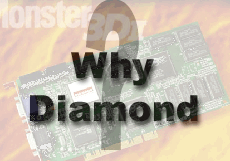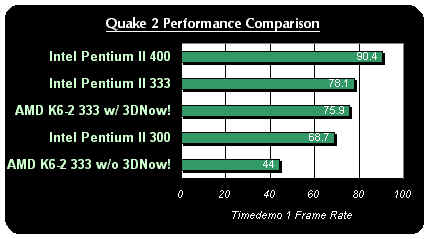
Original Link: https://www.anandtech.com/show/190
| All Voodoo2 cards are created equal - that is unfortunate to have to say, but it is also unfortunate that it is, more or less, the truth. Most boards seem to be closely based upon 3Dfx's Reference Design, a feature that detracts from the possibility of having an actual 'winner' among Voodoo2 boards. |  |
We have already seen that performance is definitely not an issue among Voodoo2 cards, simply because, like BX motherboards, they all perform within a few percent of each other. Not only are the performance differences minimal, but they are also barely reflected in real world situations, making a comparison based on performance useless.
So what really makes one Voodoo2 better than another? It is this very question that we will answer as AnandTech takes a look at one of the most highly regarded and widely used Voodoo2 cards, the now age-old Diamond Monster 3D II.
Controller
Bus Type
Memory (12MB Board)
Powerful RAMDAC
Horizontal Sync Signals
Vertical Refresh
Maximum Dot (Pixel) Rate
|
Connectors
Complete 3D Feature Set
API Support
System Requirements
|
Taking your first look at Diamond's Monster of a Video Card will reveal much more than a catchy name printed on the board, you'll see what happens to be the same basic design just about all Voodoo2 Graphics Accelerators are based on. While many manufacturers have tried to step ahead, boasting one or two new features such as TV-Output, new "optimized" drivers, or even easier to configure display utilities, it is sad to say that it just doesn't get any better than this.
Diamond realized early on, as they were the second to release a Voodoo2 board (second to only Creative Labs who cranked out their Voodoo2 cards as originally stated, before anyone else), that the battle for the king of the Voodoo2 hill would be a difficult one to win. The reason behind this is that there is simply very little room for improvement. Canopus modified 3Dfx's reference design to allow for a Voodoo2 card that was a full inch shorter than the competition's boards, however for those of you not concerned with saving that extra inch of space, the Pure3D II was simply another overpriced 3D card.
Featuring either 8MB or 12MB of on-board 100MHz Memory, every last meg able to be clocked between 90 and 100MHz using Diamond's supplied utility, and for the most part stability at overclocked memory speeds is not an issue. One difference you may notice between the Monster 3D II and most competing Voodoo2 cards is the unique markings on the board's RAM. The absence of the Silicon Magic logo may lead one to believe that the Monster 3D II's price tag should be at least somewhat lower than that of the competition, however, in reality, the price difference between the Diamond, Creative Labs, and even the Canopus Voodoo2 boards are negligible. It all boils down to who your purchase the card from, and availability of the boards on hand. An unofficial survey was conducted by AnandTech among stores local to the Raleigh, NC (USA) area about the prices and availability of Voodoo2 Graphics Accelerators. For the most part the Diamond boards were readily available and sometimes were priced between $10 and $20 below that of the competition, overall the difference wasn't too incredibly great, not large enough to tilt the balance of power in favor of Diamond at least.
Diamond packaged the Monster 3D II with a fairly thick and very difficult to manage, especially if your 2D video card and Monster 3D II happen to be installed adjacent to each other. You may want to separate your Monster 3D II from your 2D card by at least one slot to make connecting the cable easier. Diamond supplies you with a 1.5" female cable that closely resembles what can be mistaken for a tiny Floppy Drive cable. This cable is what can be used to connect two Monster 3D II's together for operation in the supported Scan Line Interleave (SLI) mode for achieving a true gamer's definition of performance. When taking advantage of Dual Voodoo2's running in SLI you not only open up your options to a world of gaming in 1024 x 768 resolutions with Z-Buffering but you also increase performance considerably at 800 x 600.
Nothing too special right? Let's take a look at the only category left to amaze the market with, let's turn to the soft side of things with the Monster 3D II's Software Installation...
The Pentium II test system AnandTech used featured an ABIT BX6 Motherboard, and a Pentium II - 400. Removing the system's case cover and finding two unoccupied PCI slots, a rarity in the cases of most tweakers who happen to have quite a few PCI peripherals, the two 12MB Monster 3D II's were installed and connected properly by the SLI cable on the inside and connected to the Matrox Millennium II AGP with the pass-through cable on the outside.
Firing up the system told Windows 95 that it was time to whip out the dusty 'Add New Hardware Wizard' as it detected not one, but two PCI Multimedia Devices (because of the two boards installed). Using the supplied Diamond Monster 3D II Installation CD the Windows 95 Monster 3D II DirectX 5 drivers were quickly found and configured for use with the two boards that found a home in the test system. Upon rebooting everything seemed to be normal, no problems, and at the same time no useless space consuming toolbars on the desktop, nothing but simplicity in its purest form.
Further inspection will reveal a new tab under your Display Properties Control Panel properly entitled Monster 3D II. From this tab you can adjust gamma settings, overclock your card, and enable/disable common Voodoo2 performance enhancing settings such as Wait for V-Sync.
The major strong point of the Diamond Monster 3D II is its game bundle, Diamond chose to include full versions of Rage's Incoming, Battle Zone, and Monster Truck Madness 2, with the 12MB card. Owners of the 8MB card will be blessed with Special Edition versions (basically like large demos) of Jedi Knight, Shadows of the Empire, and X-Wing vs Tie Fighter. Unfortunately the only full version of a game bundled with the 8MB card is Heavy Gear, a bit of a disappointment for those of you that can't fund the 12MB's desires, but offset by the inclusion by quite a few shareware/special edition titles.
Of course you'll pay for the bundle of these software titles with the card, however surprisingly enough the cost is barely any different than other Voodoo2 based cards with an inferior software package. Diamond earns the A+ in the Ease of Setup/Bundled Software Category, as they have managed to put together a piece of art worthy of the priceless Diamond title.
The performance of the Monster 3D II, as with all Voodoo2 cards out today, falls within a few percent of the competition, eliminating the need to re-run an entire suite of benchmarks spreading across multiple processor platforms.
How I Tested
Wait for VSYNC was disabled during the tests
Diamond Supplied Monster 3D II Drivers were used in conjunction with the Millennium II AGP Drivers
The Memory Clock was set at 93MHz
Quake 2 v3.14 was used (with AMD 3DNow! Drivers if necessary); The full version of Turok was used, not the downloadable demo.
Test Configuration |
|
| Processor(s): | AMD K6-3D 300 AFR Intel Pentium II - 266 |
| Motherboard(s): | Socket-7: Microstar
MSI-5169 (A5) Slot-1: Shuttle HOT-641 (BX) |
| RAM: | 1 - 64MB Corsair PC100 SDRAM DIMM |
| Hard Drive(s): | IBM Ultrastar Ultra-Wisde SCSI 3 HDD |
| Video Card(s): | 2 Monster 3D II's - Voodoo2 (12MB PCI) Matrox Millennium II (4MB WRAM - AGP) |
| Bus Master Drivers: | Intel 3.01 VIA 2.14 |
| Video Drivers: | MGA Millennium 4.03.00.3410 VIA Gart VxD |
| Operation System(s): | Windows 95 Service Release 2.1 |
3D Gaming Performance - Frame Rates - 640 x 480 Voodoo2 SLI |
|||
| --- | Quake 2 (OpenGL) |
Turok (Glide) |
Forsaken (Direct3D) |
Processor |
Demo 1 | TMark | Nuke Demo |
| AMD K6-2 333/95 w/o 3DNow! Q2 Drivers | 44.2 | N/A | N/A |
| AMD K6-2 333/95 w/ 3DNow! Q2 Drivers |
76.4 | 81.4 | 120.01 |
| Intel Pentium II 300/66 | 69.2 | 113.9 | 136.89 |
| Intel Pentium II 333/83 | 78.8 | 129.5 | 160.71 |
| Intel Pentium II 400/100 | 93.1 | 154.8 | 186.74 |
3D Gaming Performance - Frame Rates - 800 x 600 Voodoo2 (Single) |
||
| --- | Quake 2 (OpenGL) |
Forsaken (Direct3D) |
Processor |
Demo 1 | Nuke Demo |
| AMD K6-2 333/95 w/o 3DNow! Q2 Drivers |
42.8 | N/A |
| AMD K6-2 333/95 w/ 3DNow! Q2 Drivers |
59.4 | 90.37 |
| Intel Pentium II 300/66 | 58.0 | 92.26 |
| Intel Pentium II 333/83 | 59.8 | 93.86 |
| Intel Pentium II 400/100 | 60.7 | 95.09 |
3D Gaming Performance - Frame Rates - 800 x 600 Voodoo2 (SLI) |
||
| --- | Quake 2 (OpenGL) |
Forsaken (Direct3D) |
Processor |
Demo 1 | Nuke Demo |
| AMD K6-2 333/95 w/o 3DNow! Q2 Drivers |
44.0 | N/A |
| AMD K6-2 333/95 w/ 3DNow! Q2 Drivers |
75.9 | 119.23 |
| Intel Pentium II 300/66 | 68.7 | 132.16 |
| Intel Pentium II 333/83 | 78.1 | 153.17 |
| Intel Pentium II 400/100 | 90.4 | 171.60 |
3D Gaming Performance - Frame Rates - 1024 x 768 Voodoo2 (SLI) |
||
| --- | Quake 2 (OpenGL) |
Forsaken (Direct3D) |
Processor |
Demo 1 | Nuke Demo |
| AMD K6-2 333/95 w/o 3DNow! Q2 Drivers |
43.6 | N/A |
| AMD K6-2 333/95 w/ 3DNow! Q2 Drivers |
66.9 | 98.65 |
| Intel Pentium II 300/66 | 64.1 | 109.95 |
| Intel Pentium II 333/83 | 69.1 | 114.26 |
| Intel Pentium II 400/100 | 72.8 | 117.81 |

I would definitely call these numbers more than just "playable" frame rates. The only test that seemed to give the Monster 3D II a hard time was running Unreal at 800 x 600 or 1024 x 768 (SLI), in both cases, the faster system among the Pentium II/K6-2 test units seemed to be the K6-2. While Unreal has yet to attain a Timedemo-like function to achieve accurate frame rates, you can't fool the gamer when it comes to the look and feel of a title like Unreal, and it does seem to look and feel better on a K6-2 running with Dual Monster 3D II's (in comparison to a Pentium II - 400).
There is a reason companies like AMD, and gamers like Thresh (aside from $$$) use Diamond Monster 3D II's in their systems to show off both performance and image quality of games like Quake, and Unreal. This reason is simply because Diamond brings quality and a reliable product to the table. In the Voodoo2 market it all essentially boils down to which card you can pick up at a cheaper price, if that card happens to be the Monster 3D II, then so be it, while at the same time be sure to enjoy the outstanding software bundle you'll be having fun with.
Diamond Monster 3D II PCI Voodoo2
Accelerator
Price - $299 (12MB) $239 (8MB)
Website - http://www.diamondmm.com
Overall Rating - 93%
Anand Tech - Video Card Rating |
|
| 2D Performance: | N/A |
| 3D Performance: | 95% |
| Price: | 85% |
| Ease of Installation/Configuration: | 95% |
| Drivers: | 90% |
| Compatibility: | 94% |
| Bundled Software: | 98% |
| Overall Rating: | 93% |








